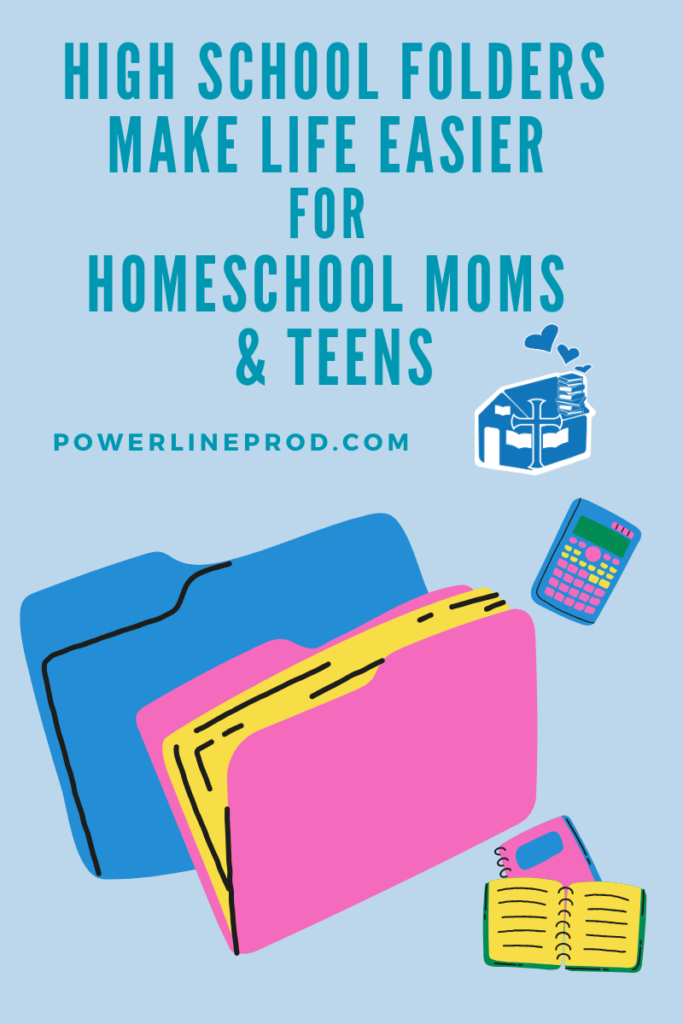Do you want to take the stress out of record keeping and grading?
C’mon. Let’s talk about a simple way to keep track of papers, assignments, grades, and tracking credits. It’s an all-in-one, easy-peasy way to homeschool high school.
The Fabulous Folder Method
All you need is a 3-prong, 2-pocket folder for each class!
Each course is different. In some classes, students read living books and write essays. In our classes, they watch videos and complete hands-on projects. Still others use traditional textbooks with projects or tests.
The folder system works for all kinds of classes.
These little folders take up so little space, yet a lot of paper and photos can fit in the side pocket. Photos of projects, essays, reports, and poetry are easy to pull out and grade.
Each morning, my teens just grab their folders and any textbooks or living books they need. They head downstairs to the dining room and get to work. When they complete assignments, essays, or reports, they put them in the side pocket. If they complete a project, they take a photo. We do fill up the math folders, so we remove old math problem papers to a back-up file folder at the bottom of the school tote. When I pick one of my teen’s folders, I can tell in a heartbeat if she is caught up with her schoolwork. I have easy access to any assignments I need to check over or grade.
Page One: Course Overview
The first page inside the prongs is an overview of the class with texts, audios, and living books listed, as well as general overview of assignments and grading information.
I use four headings:
- Textbook
- Supplemental Books & Videos
- Assignments
- Grading
If there is more than one page of writing I print it double-sided so it only takes one piece of paper.
For example, our economics class textbook is Economics, Finances, & Business. The living books include Whatever Happened to Penny Candy, Economics in One Easy Lesson, and Wealth of the Nations. Assignments include making a budget, taking career assessment tests, making a business plan, and the apartment project (a favorite!).
A history course might list the textbook as HIS Story of the 20th Century while supplemental books include the workbook full of timelines, hands-on projects, and living books for each decade. Under assignments, I might list the ones I want my son to complete like design an airport, complete pre-WWI and post-WWI maps, and write a letter to a cousin in England during the Roaring Twenties.
Sometimes for a literature course I write, “Choose 2 books per month from the following list,” and under the assignment section, “Write a book review or participate in book club for each book read.”
I keep this information brief enough to fit on one page.
Since I need grades to transcripts, I’m very clear with their grading requirements.
I also give the grading requirements, since I need grades for their transcripts. I might write it out like this: “Grade: assignment completion 50%, test scores 25%, and ability to communicate with Mom 25%.” Grades can be based on creativity, essay grades, neatness, diligence, test scores, group discussion, hands-on assignments, exhibits, projects, or number of books read. I use rubrics for writing papers. This has really helped me because we don’t use grades until high school and only then because we need to put them on the transcripts.

Page Two: Detailed Assignment Checklist
This section is so worth the time it takes to make it!
While the first page inside the prongs is the course overview, the next pages are a detailed assignment check-off list. Teens check off assignments as they finish them. My charts are super simple but you could insert a chart or print up these pages in Excel.
I take the time each summer to make these detailed lists by week for the upcoming year.
Here’s an example.
September Week One
Read HIS Story of the 20th Century pages 7-30
HIS Story of the 20th Century Workbook pages 29-42
Read Kim by Rudyard Kipling (1/3 of book)
Complete History Lab: Splatter Painting
All Jimmy has to do is check off each line when he is finished. I can tell immediately if he’s done the work or not.
Simple, right?
Even better is that this creates a written record of what Jimmy has completed!
What I love about this system is how easy it is to use for the homeschool mom and her students. The record keeping system is easy for teens to keep up with, the folders are easy to store, and Mom has everything at her fingertips. I love keeping things simple!
My favorite thing is picking up the folder, seeing if my teen is caught up, and grading the work in pockets all in one step.
This easy folder system has served me well for five high schoolers and interestingly, many of my kids continued the system into college.
I encourage you to try my simple folder method for yourself! Let me know how it works for you!
Until next time, Happy Homeschooling!
Meredith Curtis

Welcome to the Homeschooling Teens Giveaway!
We’ve teamed up with bloggers who share your passion for creating an enriching homeschool experience for teens. As a token of appreciation for the amazing homeschooling teen community, two families will each receive a $75 gift card to support their teen’s homeschooling journey.
We understand the dedication it takes to homeschool, especially when your teen is your focus. This giveaway is our way of saying thank you for being part of this incredible community.
How to Enter:
Entering is a breeze! Click on the Rafflecopter link at the bottom of the blog this page , follow the instructions, and you’ll be in the running to win a fantastic gift card!
There are lots of entry options in the Rafflecopter form below – the more entries you complete, the better your chances of winning! I know it might feel a little tedious to go through all the steps, but isn’t a shot at $75 totally worth it?
Plus, these awesome bloggers generously chipped in their own money to make this giveaway happen. I hope you’ll take a moment to check each of them out—you might even discover some great new blogs to follow!
Important Details:
- Entries accepted through January 22, 2025.
- Winner announcement Jan 25, 2025.
- By entering the giveaway you are giving the participating bloggers permission to email you. (you may unsubscribe at any time)
- For all terms and conditions, refer to the Rafflecopter.
If you have more questions, read the Terms and Conditions on the Rafflecopter.
We understand the dedication it takes to homeschool, especially when your teen is your focus. This giveaway is our way of saying thank you for being part of this incredible community.
Feel free to share this news with your fellow homeschooling friends. The more, the merrier!
a Rafflecopter giveaway